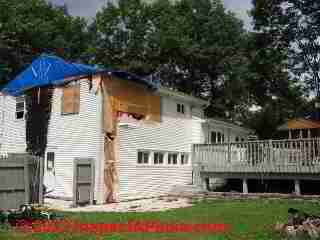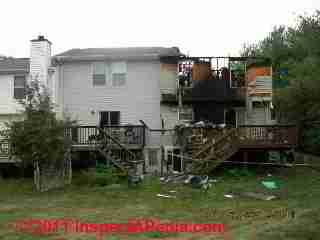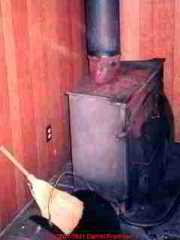How Do You Know if Chimney Fire
 Chimney Fires & Fire Prevention
Chimney Fires & Fire Prevention
Metallic & Masonry Chimney Safety Advice
- POST a QUESTION or Comment about chimney fires, chimney causes, what to practice if you accept a chimney fire, & how to prevent a chimney burn down
InspectAPedia tolerates no conflicts of involvement. We have no relationship with advertisers, products, or services discussed at this website.
Chimney fires:
Hither are photos and examples of the crusade and furnishings of a chimney fire traced to an unattended woodstove.
Steps to prevent a chimney fire from a fireplace, woodstove, or woodstove or fireplace insert safety include making sure that your metal chimney or "flue" is safe.
"Prophylactic" means clean, properly constructed and installed, using proper materials and proper fire clearances.
Nosotros besides provide an Commodity INDEX for this topic, or you can try the page top or bottom SEARCH BOX as a quick way to notice data you need.
Fireplace Safe Advice from the US Consumer Product Safety Commission - US CPSC Certificate 5047 - expanded
 If You Have A Chimney Fire [or any other business firm fire] Here is What to Practice
If You Have A Chimney Fire [or any other business firm fire] Here is What to Practice
Know what to practise in the event of a chimney burn down:
- Get everyone out of the building.
- Call the fire department from a cellphone or neighbor's telephone.
- If you can safely re-enter the building and admission the fireplace or woods or coal stove without condign trapped in the building:
- Close downwardly the combustion air supply to the woodstove or coal stove. If you accept a fireplace that has glass firedoors, shut them.
- If there is a manual flue damper in the wood stove or coal stove flue vent connector (the stackpipe between the stove and the chimney), close it.
- If you lot have a chimney fire extinguisher device put it into the woodstove or fireplace or coal stove. Chimflex™ sells a chimney fire extinguisher "stick" that can be ignited and placed "alongside the fire" in a fireplace or woodstove to attempt to suppress a chimney fire.[5] Nonetheless keep in mind that the fire is in the chimney, non the woodstove or fireplace.
Watch out: be sure to follow the chimney burn down extinguisher device manufacturer'southward instructions or yous may brand matters worse.
- If you take a dry out chemical burn extinguisher (recommended for anyone using a woodstove, coalstove or fireplace, use it to extinguish the fire in the fireplace or woodstove.
- While waiting for the burn down section, if you have admission to a garden hose, utilise it to moisture down the roof surfaces to reduce burn down spread.
The US CPSC offers some succinct advice to avoid having a plush and dangerous house fire or an unsafe gas leak take a chance. Consumer Product Safety Commission Metal Chimneys: Safety Alert CPSC Certificate #5047 [seven]. Nosotros take added to the original CPSC information. For a succinct pamphlet on chimney and woodstove safety see
this CHIMNEY & WOODSTOVE Fire Rubber Lawmaking Information Sail [PDF] from Vermont.
Before Using a Wood Stove, Coal Stove, or Fireplace Insert: Safe Checks

Details about woods stove choices, installation, inspection, repair and rubber are at present
at Forest STOVE OPERATION & SAFETY.
Excerpts are below.
[Before using your wood stove, coal stove in the coming or current heating flavor] the United states of america Consumer Product Safety Commission [since 1983 has] strongly urged you, if you have a [wood stove or coal stove] or fireplace connected to a metal chimney, to check for any harm that may accept occurred in the past heating flavor.
[Click to overstate whatever prototype]
Fifty-fifty when the heating appliance is properly installed, people with both metal and masonry chimney systems should oft bank check the chimney for creosote deposits, soot build-upwards or physical impairment. Details are
at CREOSOTE Burn HAZARDS.
The The states Consumer Product Condom Commission advises owners of metallic woodstove or fireplace insert chimneys to:
- Be sure that the chimney and stove pipe were installed correctly in accordance with the manufacturers' recommendations and local building codes. If there is any doubt, a building inspector or fireman can make up one's mind whether the system is properly installed.
- Take the chimney checked routinely by a chimney "sweep" at least once a yr, and more than frequently if a stove is heavily used (for example, if it'south used as a primary rut source for the home).
- Check air intake and flue damper operation: Bank check that the chimney flue damper and/or wood stove or coal stove air intake damper can be operated properly. While checking a flue damper you lot may become a clue that the flue is heavily coated with creosote if you can no longer motion the damper freely.
Watch out: if the incoming combustion air cannot exist shut down because of leaky woodstove or coal stove gaskets or other damage, the coal stove, woodstove, or pellet stove is unsafe as its burn-rate cannot be regulated.
See DAMPERS & Typhoon REGULATOR TYPES
- Always operate your appliance within the manufacturers' recommended temperature limits. Too low a temperature increases creosote build-up and also high a temperature may lead to a fire. Chimney temperature monitors are bachelor and should be used.
- Make certain that your home has working smoke detectors properly installed and located
- Make sure that your home has appropriate fire extinguishers, located past the home exit doors, and of an appropriate size and type if y'all use a fireplace or woodstove.
If yous take had a fire or other prophylactic trouble with your chimney, please provide this information to the Committee by calling the Committee'southward cost-free Hotline 800-638-CPSC.
Enquiry
- Isenhour, Jerry East., Sr., Chairman James P. Brewer Ashley Eldridge P.C. Luter Iii, David South. Johnston, CHIMNEY FIRES: CAUSES, EFFECTS & EVALUATION [PDF] (2007) Chimney Safety Institute of America 2155 Commercial Bulldoze Plainfield, Indiana 46168 (317) 837-5362 Fax: (317) 837-5365 www.csia.org - retrieved 2021/05/19 original source: https://www.csia.org/uploads/nine/0/7/3/90732795/chimney_fires_white_paper.pdf
...
Continue reading at CREOSOTE FIRE HAZARDS or select a topic from the closely-related articles below, or see the complete Commodity INDEX.
Or see these
Recommended Articles
- CHIMNEY CHASE Fire
- CHIMNEY FIRE Study & chimney fire safety advice: Vista Burn Department, [PDF]
- FIREPLACE DAMAGE & UNSAFE HEARTHS - fireplace and hearth hazards that tin can exist constitute by visual inspection
- OIL BURNER ROARING Racket
Suggested citation for this web page
CHIMNEY Burn ACTION / PREVENTION at InspectApedia.com - online encyclopedia of edifice & environmental inspection, testing, diagnosis, repair, & trouble prevention advice.
Or meet this
INDEX to RELATED Articles: ARTICLE INDEX to CHIMNEYS & FLUES
Or utilize the SEARCH BOX found below to Ask a Question or Search InspectApedia
...
Enquire a Question or Search InspectApedia
Try the search box merely below, or if you adopt, post a question or comment in the Comments box below and we will respond promptly.
Search the InspectApedia website
Annotation: appearance of your Comment beneath may exist delayed: if your annotate contains an image, spider web link, or text that looks to the software as if it might exist a spider web link, your posting will appear after it has been approved by a moderator. Apologies for the delay.
Technical Reviewers & References
Click to Bear witness or Hibernate Citations & References
Publisher InspectApedia.com - Daniel Friedman
Source: https://inspectapedia.com/chimneys/Chimney_Fires.php
0 Response to "How Do You Know if Chimney Fire"
Post a Comment